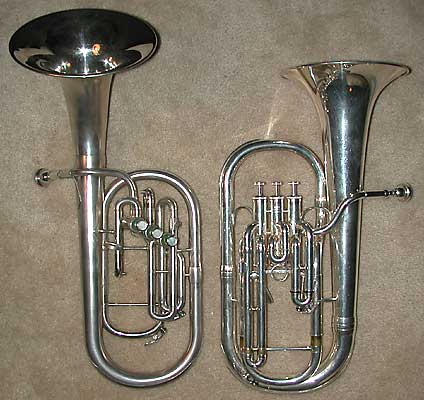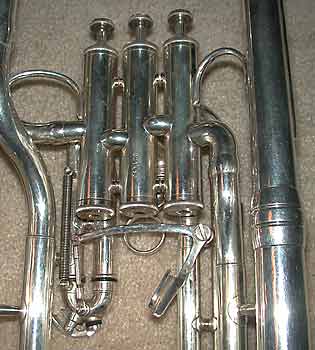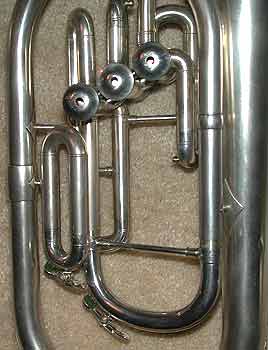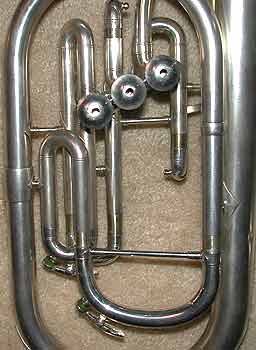
 |
Two basic types of alto horns: bell front and upright. |
The instruments in the picture above are both alto horns. The bell front instrument on the left is a Besson 2-20 alto horn in F and E-flat. The upright bell instrument on the right is a Yamaha YAH-601ST. To get some idea of their sound, you can hear "Bare Necessities" played on the Besson 2-20 configured in the key of E-flat. (Keep in mind that the mouthpiece, player, and playing style affect the sound significantly.)
Standard brass band instrumentation includes three E-flat horns, and the upright alto horn shown above is owned by the Sheldon Theatre Brass Band. When discussing brass bands, it's helpful to remember that the term "alto horn" for this instrument is not universal. In the U.S.A., the usual term is "alto horn." Elsewhere, especially in England, the same instrument is often referred to as a "tenor horn" in E-flat. Within the brass band context, the shorter term "horn" is commonly used. The "T" in the model number denotes the trigger, which, when pushed, extends the first valve slide. As shown here in the rear view of the valve section, the trigger lies under the player's left thumb. When pressed, it moves a lever that pivots on a brace between the tubes of the third valve slide and attaches to the bottom of the first valve slide. Pressing the lever extends the first valve slide, lowering the pitch. When the player releases pressure on the trigger, a spring attached to the first valve slide returns the first valve slide to the closed position. On this instrument, the first valve trigger is especially useful for lowering the pitch of fourth line F and all of the A's. The YAH-601ST is no longer manufactured, having been replaced in Yamaha's product line by the YAH-602. The YAH-602 has better response and focus in the high range, but unfortunately it does not have a pitch adjustment trigger. |
 |
The Besson 2-20 alto horn can be configured in E-flat, as shown on the right below, or in F, as shown on the left below. Unlike nineteenth-century French horns, which relied on detachable crooks for fundamental pitch changes, the Besson 2-20 has all the necessary parts permanently attached. These pictures show rear views of the instrument.

|
 |
As shown in the picture on the left, the main tuning slide is connected to tubing that leads into the third valve, bypassing a separate loop near the left side of the instrument. At first glance, it seems odd to see an isolated loop of tubing that has its own water key!
The extra loop, which lowers the pitch a whole step, can be easily incorporated into the instrument's basic air column for playing in E-flat. This requires cross-connecting the main tuning slide and the E-flat loop as shown in the picture on the right. For proper intonation in the key of E-flat, the three valve slides need to be extended proportionally, as they are in the picture. Lines scored on each of the inner valve slides indicate how far out to pull the slide.